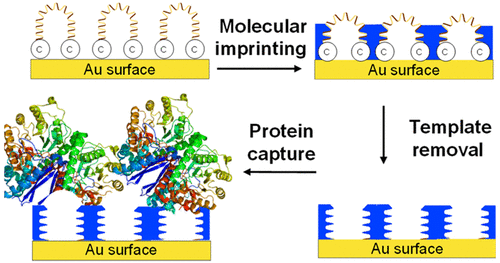当前位置:
X-MOL 学术
›
Anal. Chem.
›
论文详情
Our official English website, www.x-mol.net, welcomes your feedback! (Note: you will need to create a separate account there.)
Self-Assembled Monolayer Epitope Bridges for Molecular Imprinting and Cancer Biomarker Sensing.
Analytical Chemistry ( IF 6.7 ) Pub Date : 2020-03-13 , DOI: 10.1021/acs.analchem.9b03813 Julia Drzazgowska 1 , Bianca Schmid 1 , Roderich D Süssmuth 1 , Zeynep Altintas 1
Analytical Chemistry ( IF 6.7 ) Pub Date : 2020-03-13 , DOI: 10.1021/acs.analchem.9b03813 Julia Drzazgowska 1 , Bianca Schmid 1 , Roderich D Süssmuth 1 , Zeynep Altintas 1
Affiliation

|
The research in biomedicine, cell signaling, diagnostics, and biocatalysis rely on selective protein binders that specifically capture a protein in a complex medium for either preparative or analytical use. These molecules are generally of biological origin and exposed to instability, denaturation, high cost, and inherently low binding capability. Imprinted polymers, serving as the artificial protein binders, demonstrate good potential to overcome these drawbacks. In this study, a novel epitope imprinting strategy is reported by employing double-cysteine-modified peptides as the templates and adsorbing the templates on a gold surface by means of forming self-assembled monolayer bridges, followed by electropolymerization to create a polymer network. The imprinted surface was initially designed to demonstrate specific affinity toward a short peptide (i.e., the epitope) or a target protein (i.e., neuron specific enolase) in buffer. This surface was subsequently used to measure the cancer biomarker in human serum that allows detecting 12 times lower concentration than threshold level of the biomarker. The molecular receptors exhibited a Kd < 65 pM for their respective target protein and low cross-reactivity with four nonspecific molecules. As compared to current strategies for the epitope imprinting, for example, through traditional, vertically adsorbed, or histidine-modified peptides, such a molecularly tunable system based on a surface-imprinting process may provide more efficient sensing systems with desirable affinity, sensitivity, and specificity in diagnostics applications.
中文翻译:

自组装的单分子表位桥用于分子印迹和癌症生物标志物传感。
在生物医学,细胞信号转导,诊断和生物催化方面的研究依赖于选择性的蛋白质结合剂,该结合剂可以特异性地捕获复杂介质中的蛋白质以用于制备或分析用途。这些分子通常是生物来源的,并具有不稳定,变性,高成本和固有的低结合能力。用作人工蛋白质粘合剂的印迹聚合物具有克服这些缺点的良好潜力。在这项研究中,通过使用双半胱氨酸修饰的肽作为模板并通过形成自组装单层桥将模板吸附在金表面上,然后进行电聚合以创建聚合物网络,报道了一种新颖的表位印迹策略。即表位)或缓冲液中的靶蛋白(即神经元特异性烯醇化酶)。该表面随后被用于测量人血清中的癌症生物标志物,其允许检测比生物标志物的阈值水平低12倍的浓度。分子受体的各自目标蛋白的K d <65 pM,与四个非特异性分子的交叉反应性低。与当前的表位印迹策略相比,例如,通过传统的,垂直吸附的或组氨酸修饰的肽,这种基于表面印迹过程的分子可调系统可以提供更有效的传感系统,并具有所需的亲和力,灵敏度和诊断应用程序的特异性。
更新日期:2020-03-16
中文翻译:

自组装的单分子表位桥用于分子印迹和癌症生物标志物传感。
在生物医学,细胞信号转导,诊断和生物催化方面的研究依赖于选择性的蛋白质结合剂,该结合剂可以特异性地捕获复杂介质中的蛋白质以用于制备或分析用途。这些分子通常是生物来源的,并具有不稳定,变性,高成本和固有的低结合能力。用作人工蛋白质粘合剂的印迹聚合物具有克服这些缺点的良好潜力。在这项研究中,通过使用双半胱氨酸修饰的肽作为模板并通过形成自组装单层桥将模板吸附在金表面上,然后进行电聚合以创建聚合物网络,报道了一种新颖的表位印迹策略。即表位)或缓冲液中的靶蛋白(即神经元特异性烯醇化酶)。该表面随后被用于测量人血清中的癌症生物标志物,其允许检测比生物标志物的阈值水平低12倍的浓度。分子受体的各自目标蛋白的K d <65 pM,与四个非特异性分子的交叉反应性低。与当前的表位印迹策略相比,例如,通过传统的,垂直吸附的或组氨酸修饰的肽,这种基于表面印迹过程的分子可调系统可以提供更有效的传感系统,并具有所需的亲和力,灵敏度和诊断应用程序的特异性。











































 京公网安备 11010802027423号
京公网安备 11010802027423号